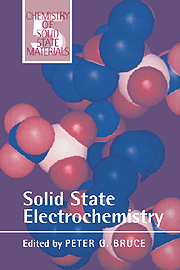Book contents
- Frontmatter
- Contents
- Preface
- 1 Introduction
- 2 Crystalline solid electrolytes I: General considerations and the major materials
- 3 Crystalline solid electrolytes II: Material design
- 4 Ionic transport in glassy electrolytes
- 5 Polymer electrolytes I: General principles
- 6 Polymer electrolytes II: Physical principles
- 7 Insertion electrodes I: Atomic and electronic structure of the hosts and their insertion compounds
- 8 Electrode performance
- 9 Polymer electrodes
- 10 Interfacial electrochemistry
- 11 Applications
- Index
11 - Applications
Published online by Cambridge University Press: 14 September 2009
- Frontmatter
- Contents
- Preface
- 1 Introduction
- 2 Crystalline solid electrolytes I: General considerations and the major materials
- 3 Crystalline solid electrolytes II: Material design
- 4 Ionic transport in glassy electrolytes
- 5 Polymer electrolytes I: General principles
- 6 Polymer electrolytes II: Physical principles
- 7 Insertion electrodes I: Atomic and electronic structure of the hosts and their insertion compounds
- 8 Electrode performance
- 9 Polymer electrodes
- 10 Interfacial electrochemistry
- 11 Applications
- Index
Summary
Introduction
In the early part of this century, many types of solid electrolyte had already been reported. High conductivity was found in a number of metal halides. One of the first applications of solid electrolytes was to measure the thermodynamic properties of solid compounds at high temperatures. Katayama (1908) and Kiukkola and Wagner (1957) made extensive measurements of free enthalpy changes of chemical reactions at higher temperatures. Similar potentiometric measurements of solid electrolyte cells are still made in the context of electrochemical sensors which are one of the most important technical applications for solid electrolytes.
Another application of solid electrolytes is to be found in the field of power sources. Baur and Preis (1937) proposed a fuel cell system with an oxide ion conductive solid. The solid oxide fuel cells (SOFC) are attractive electric power generation systems, and over the last decade research devoted to their development has become intense. In 1967, Yao and Kummer found that β-alumina exhibited high sodium ion conductivity, and Weber and Kummer (1967) proposed a sodium-sulphur battery with β-alumina. This type of battery may be attractive as a power source for electric vehicles and for electric energy storage as part of a load-levelling system in consumer power distribution. Solid electrolyte cells, which operate at room temperature, have been developed over the past two decades.
- Type
- Chapter
- Information
- Solid State Electrochemistry , pp. 292 - 332Publisher: Cambridge University PressPrint publication year: 1994



